Meet our Investigators: April Levin, MD
Department of Neurology at Boston Children’s Hospital | Instructor of Neurology, Harvard Medical School
IDDRC member since 2019
Read full bio>
What is your main research focus?
My research focuses on developing biomarkers for autism and related neurodevelopmental disorders. I’m particularly interested in using electroencephalography (EEG) for this purpose because EEG reflects activity of the neural circuits that translate activity from genotype to phenotype, and from individual cells into meaningful behavior. EEG-based biomarkers can therefore give us insight into the circuit-level mechanisms underlying various neurodevelopmental disorders.
What led you to pursue research career and/or interest in IDD?
I first became interested in IDD back in high school, when I took my first trip to Romania to volunteer in an orphanage. Many of the children I met there showed quite atypical development, along with physical features like short stature and abnormal motor activity. I wondered how changes in the environment, like lack of expected attachment to adults and play, could lead to such tangible changes in the body and brain. I majored in neuroscience as an undergraduate, went to medical school, did a residency in child neurology, completed a fellowship in autism and behavior – and then realized from all of that how little we really know about how the brain works. Along the way I had some fantastic clinical and research mentors, who encouraged me to ask hard questions and then try to find the answers.
Are you interested in collaborating or offering any collaborative opportunities? If yes explain briefly.
Absolutely. I think the most substantial breakthroughs in research often some when researchers from different fields are able to speak the same scientific language well enough to make meaningful connections across otherwise separate disciplines. For the work that I do, I’m always looking for people with backgrounds in fields like engineering, neuroscience, psychology, and mathematics. We want to be able to synthesize the existing neuroscience research from animal models to figure out what patterns of activity on EEG might best index underlying mechanisms and pathways to IDD, and then we want to use innovative but mathematically solid signal processing techniques to pull those patterns out from the data we collect. Lately we’ve also started some work looking at how the brain processes incoming sensory information, so we’re looking to collaborate with people who have deep expertise in hearing, vision, touch, etc. We have open positions for a post doc, research scientist, and research assistant right now – so if you know of anyone who would be interested, please have them reach out to me!
Any comments on the services of a core/or particular equipment that advances your current research?
I co-direct the Clinical Neurophysiology Core here at Boston Children’s Hospital, and it’s been interesting to see the variety of projects that can make use of the core. We’ve been particularly surprised at how much interest there is in using novel computational and signal processing techniques – there’s so much information embedded in our data that goes untapped otherwise. For my own research, I also use core resources for phenotyping and statistical analysis. I think the cores are a great way to extend research projects in new and exciting ways that wouldn’t be possible in a more isolated setting.
Interesting tidbit about Dr. Levin
Outside of work I like the sport formerly known as CrossFit, gardening, and cooking excessively elaborate meals for family and friends. I don’t claim to be particularly great at any of these things, but I’m solidly mediocre at all of them. I like spending time with my family – they’re a lot of fun. I’m also always up for a good handstand contest. (A patient challenged me to one recently. I won.)



